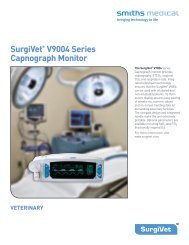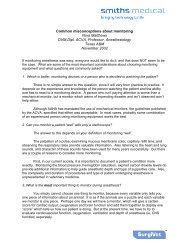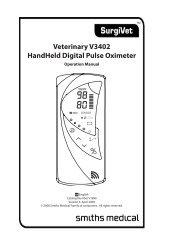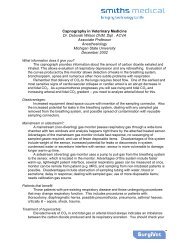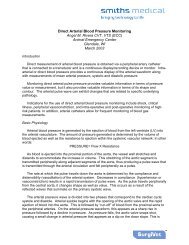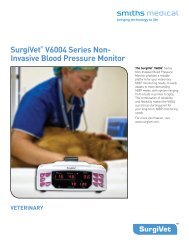Surgivet® V1030 Hand-Held Pulse Oximeter
Surgivet® V1030 Hand-Held Pulse Oximeter
Surgivet® V1030 Hand-Held Pulse Oximeter
You also want an ePaper? Increase the reach of your titles
YUMPU automatically turns print PDFs into web optimized ePapers that Google loves.
Intended Use<br />
Chapter 2: Intended Use and Monitor Features<br />
Chapter 2: Intended Use and Monitor Features<br />
The veterinary pulse oximeter is intended to be used for continuous monitoring of a patient’s<br />
functional oxygen saturation (%SpO 2 ), pulse rate ( p ), pulse signal strength, and <strong>Pulse</strong><br />
amplitude Index (PI) readings. It is equipped with audible and visual alarms. It may be used by<br />
veterinarians and trained veterinary professionals. It can be used on patients with low perfusion<br />
or during patient motion. The <strong>V1030</strong> may be used in the hospital or clinical environment.<br />
WARNING! This device is intended for use by persons trained in veterinary professional<br />
health care. The operator must be thoroughly familiar with the information in<br />
this manual before using the device.<br />
WARNING! The monitor was not designed or tested to be an apnea monitor.<br />
Monitor Features<br />
• Provides fast, reliable SpO 2 , pulse rate, and pulse signal strength measurements.<br />
• Maintains accurate readings during periods of patient motion and when monitoring<br />
patients with low perfusion.<br />
• Ideally suited for use in veterinary facilities or clinical environments.<br />
• Portable and lightweight. Weighs only 330 grams (12 ounces) with 4 “AA” batteries.<br />
• Power options include four (4) standard “AA” (type IEC LR6) alkaline batteries, a<br />
rechargeable Lithium Ion battery pack, or an AC power adapter.<br />
• Rechargeable battery life is approximately thirty (30) hours (new battery).<br />
• An easy to read battery gauge indicates the charge level and provides a low battery alert.<br />
• Large, bright, easy-to-read LED display indicates SpO 2 and pulse rate measurements.<br />
• 2 Nine-segment LED bar graphs indicate pulse signal strength and <strong>Pulse</strong> amplitude Index.<br />
• An audible “beep” sounds with each pulse beat. The volume can be adjusted or turned off.<br />
The pitch of the pulse “beep” corresponds to SpO 2 value.<br />
• The alarm indicator on top of the oximeter lights up to communicate patient alarm<br />
information.<br />
• SpO 2 and pulse rate averaging settings are user-selectable.<br />
• User-adjustable trend storage rate, ranging from 2 to 30 seconds per sample, provides<br />
flexibility for many applications.<br />
• Optional docking station transforms the device into a table top pulse oximeter, and can<br />
also be used to recharge the monitor’s lithium Ion battery pack, and a spare battery pack.<br />
• Optional printer allows for printing of trend information or real time data logs.<br />
Theory of Operation<br />
The pulse oximeter determines %SpO 2 and pulse rate by passing two wavelengths of low<br />
intensity light, one red and one infrared, through body tissue to a photodetector. Information<br />
about wavelength range can be especially useful to clinicians. Wavelength information for this<br />
device can be found in the SpO 2 Specifications section of this manual.<br />
Veterinary <strong>V1030</strong> <strong>Hand</strong>-<strong>Held</strong> <strong>Pulse</strong> <strong>Oximeter</strong> Operation Manual 2-1


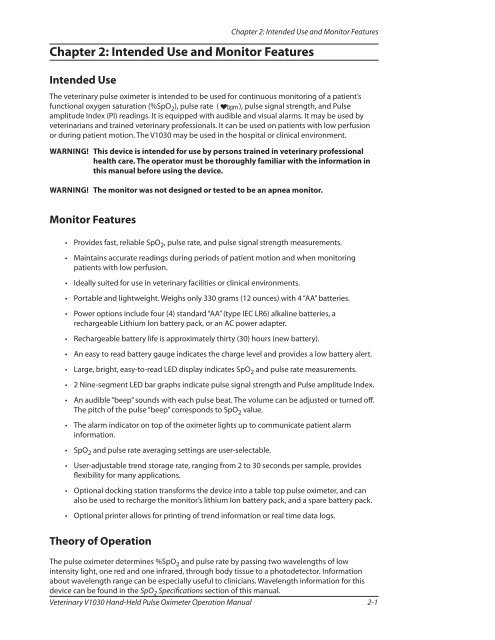
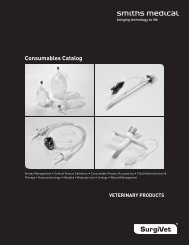
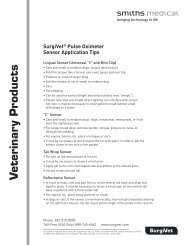
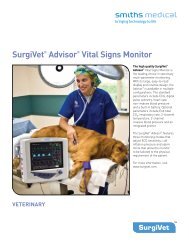
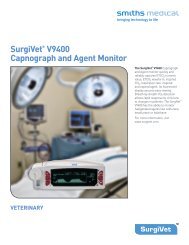
![Redemption Form [PDF] - SurgiVet](https://img.yumpu.com/37386077/1/190x245/redemption-form-pdf-surgivet.jpg?quality=85)
![Redemption Form [PDF] - SurgiVet](https://img.yumpu.com/37386066/1/190x245/redemption-form-pdf-surgivet.jpg?quality=85)
